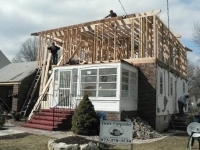Clothes Dryer Vent Line
In the last 2 days, I have inspected two 2nd floor washer/dryer installations.
- It makes sense to have these appliances as close as possible to the source of most of the Laundry.
- However, when retro-fitted on the bedroom level, they have to be squeezed into a small footprint, so you do not loose a whole bedroom. Often, this is a former closet.
- To disengage the dryer (for vent line cleaning), you need access to the rear of the dryer, so you can disconnect the vent line (normally clamped on).
- In a tight installation, that requires pulling the washer out. Since the washer is the heavier appliance, this makes it a 2 man job (= increased cost).
- For comparison, when a 'Hard Duck' adaptor is used, the dryer can be pulled out directly. This reduces vent line cleaning to a single man job, taking max. 15 minutes.
That makes it easy to avoid this scenario:
If you are working from home during the Covid-19 situation, now would be a good time to schedule a cleaning (and free evaluation of your dryer vent line design/installation).
Please send me a PM if interested.
In order to add a comment – you must Join this community – Click here to do so.
Sponsored Business
Promote your business here - Businesses get highlighted throughout the site and you can add a deal.













Full disclosure: I am not a plumber or HVAC professional, just offering some observations here.
Doing handyman work in the MSO area, I have seen quite a few dryer installations, and without exception, all have had vent line installations which ranged from poor through bad to outright dangerous (house fire waiting to happen).
FIRST: Dryer vent lines carry the lint that is not trapped in the dryer lint filter. If the exhaust velocity is too low, the lint will settle in kinks & low velocity zones in the vent line. Those lint pockets are a source of house fires.
Dryers are designed with adequate exhaust velocity, but can only achieve that velocity if there is a smooth path vent line. Kinks, turns & semi-crushed flexible lines slow the velocity, leading to lint problems.
SECONDLY: When you have adequate exhaust velocity, the dryer is much more efficient (shortening the drying time, and thus reducing the energy bill - whether gas or electric).
A common problem is that a flexible tubing is used (hopefully not the plastic covered type, that is a house fire waiting to happen). When the dryer is pushed back towards the wall, the tubing gets kinked (or crushed), introducing the lint problems and restricting the exhaust velocity.
One of my customers in West Orange found a solution. She ordered a Hard Duck adaptor, developed by a Long Island contractor. When installed, the dryer pushes straight back onto a funnel shaped connection, that leads into a hard duct vent line. For more details, please see: www.hardduck.com. I have since installed one more for a customer in Maplewood, who is very happy with their improved dryer performance.
I have no commercial interest in this, as Hard Duck sells directly to the public only. However, if you would like installation assistance, I wouldn't mind hearing from you.